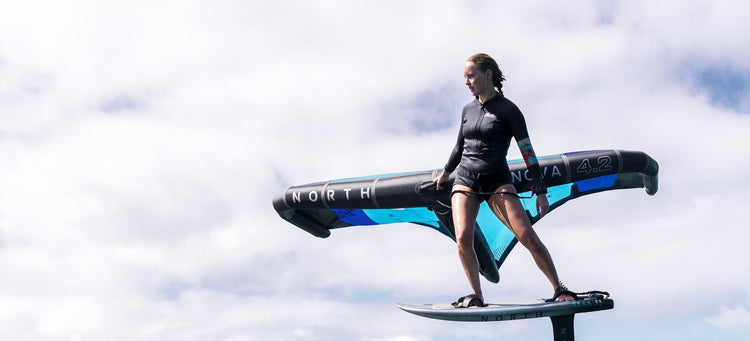My introduction to Wing Foiling
I'll never forget the day my boss at the kite school I was working at threw me into the deep end, announcing that we wouldn't be kiting after lessons that day. Instead, I had to learn wing foiling to teach it the next morning! He set me up with a 95 liter SUP foilboard and a 5m wing in 25 mph winds, leaving me to figure it out. At the time, no one on the island knew how to wing foil, let alone teach it.
What is Winging?
Wing foiling is an exhilarating water sport that combines a hand-held inflatable wing with a hydrofoil board. Standing on a board that has a foil (an underwater wing) mounted on it you hold a lightweight wing that catches the wind. As the wing generates speed it converts to lift on the foil, lifting the board above the water, creating a sensation of flying over the surface.
Why Wing Foiling?
Wing foiling, also known as winging or wing foil, has become incredibly popular. It combines the freedom of surfing, and the thrill and flight of kiteboarding, into one electrifying experience. In this blog, Green Hat will guide you through the essentials of getting started with winging. Learn how to choose the best wing size, board, and accessories to ensure you're beach-ready and equipped to dive into this exciting new sport.
Before You Buy: Key Considerations
Skill Level and Progression Path
I have been teaching winging for as long as the sport became mainstream in 2019 and the clear path to success is to break things down into two components : sailing (flying the wing) and foiling. Interestingly, I’ve noticed that windsurfers catch on to the sailing part extremely quickly whereas kiteboarders tend to be stronger with board control and foiling but struggle with flying the wing. Based on these observations, a program was developed that spans 3 days:
Day 1: Flying the wing
Start with wing handling basics on terra firma. You’ll learn flipping the wing, proper hand position, and correct body positioning for upwind and downwind and maybe a leading edge jibe. Once comfortable on land, we move things to the water either using a large windsurfing board with a daggerboard or a large SUP with a center fin. You ‘ll practice all the skills learned on land and achieve the ultimate goal of going upwind.
Day 2 Learning to Foil
We switch focus and work on the foiling through an Efoil lesson. This teaches you the principles of getting up on the foil and helps you experience what it feels like to be up there. Board pumping techniques will be covered to learn how to maintain flight and voilà!
Day 3 Putting it all together
The grand finale. You’ll have the wing in your hands and a foil under your feet. Using the right wing size and a large foil, you’ll experience your first flight!
Remember that everyone progresses differently and has their own learning journey. It is important to take your time mastering the basics as your foundation needs to be solid for long-term success.
Budget & Planning
As with many other activities, the right gear to start a sport is rarely the right gear to grow into an advanced level. Therefore, it is important to plan ahead. Do you want a board that will take you all the way through the intermediate level but may give you hell in the beginning? Or should you get the large beginner board that will facilitate learning quickly and then replace it when you have outgrown it? The choice is yours! The great news is that the first inflatable wing you purchase you will keep on your entire journey. A few additional wings will be needed to fill your quiver and be able to wing foil in every wind condition.
Local Conditions
The appropriate gear for you here in New Jersey is not the same as for someone from Brazil, Colombia or Hawaii. Learn about the typical wind speeds at your local spot, go out and talk to the locals, and contact your local kiteboarding shop. What kind of water conditions will you have to learn in - ocean or flat water? You will be on a foil, and hydrofoil masts range from 35cm to 120cm so knowing about water depth is of paramount importance as well. Consider water access - where are the local launch sites and are they safe and adequate for beginners? Green Hat has compiled a list of NJ Kite Launch sites so check them out here.
Storage and Transport Capabilities
Think about where you live, do you have enough space to accommodate all your new wing gear? What about your vehicle - a minivan or a compact car? Wings come in compact backpacks so that is not an issue but your beginner hard board can be quite large, raging from 5’8’’ to 6’4’’ in length, depending on the volume you need. The alternative is an inflatable board, they pack into a bag that fits most car trunks.
Essential Gear Components - The Wing
In wing foiling, a wing is a specially designed sail that generates lift and propulsion when moving through the air. The wing has multiple handles or a boom along the center strut for gripping and control. As the wing moves through the air at an angle to the wind, the curved upper surface deflects the wind downward, generating power. This lift propels the board and rider forward. The rider controls the wing's angle and orientation using the handles, adjusting the power and direction.
There are a variety of wing designs optimized for different riding styles and conditions. Wave wings prioritize stability and drift in surf, freestyle wings are built for tricks, and freeride wings balance, versatility and learning. The right wing depends on your body weight, your fitness level, your riding style and preferences, your objectives, your budget, and the environment you'll be riding in.
Size Selection
The general rule is that the weaker the wind, the bigger the wing and vice versa. However, as a beginner you usually want to go a slightly bigger for more power, as this can make getting up on the foil easier. Ideally you want to start practicing handling the wing at about 11-17 mph, and once you are comfortable with that, you really need 18-23 mph to get foiling easily. Under those conditions, here are the guidelines:
- Weight under 150 lbs? Start with a 4 metre wing.
- Weight between 150-180 lbs? A 5 metre wing is more suitable.
- Weight over 180lbs? A 6 metre wing is better for you.
Materials
Construction materials like Dacron, Ripstop, and Aluula also impact a wing's performance and weight. Dacron is known for its durability and ability to hold its shape; it is strong and resistant to stretching, but heavy. Ripstop is the most popular material, with most wings using multi-strand Ripstop which provides increased strength and durability and is much lighter than dacron. Most conventional wings are constructed from a mix of Dacron and Ripstop, with Dacron for the leading edge and Ripstop for the canopy. Alulla is the new craze; it is much stiffer and lighter than traditional Dacron but at a much higher price point. High-end wing leading edges and struts are made of this material.
To have a window or not to have a window!?
Windows on wing foil wings are a debated topic among riders, offering both benefits and drawbacks. On the plus side, windows enhance visibility, allowing riders to spot obstacles, maintain awareness, and prevent collisions, especially for beginners in busy areas. However, they may slightly weaken the wing's structure, require more delicate handling, and potentially impact performance due to added weight.
In cold weather, windows may become less flexible, fog up, or degrade faster. Ultimately, the decision to use a wing with windows depends on personal preference but if you plan on using it during the winter on skis, skip the window. Overall, beginners may appreciate the added visibility, while experienced riders may find them less necessary. Proper handling and awareness remain crucial for safe riding.
Handle Configuration
Handle configurations cater to different rider preferences and skill levels, offering three main types: hard handles, soft handles, and booms. Hard handles provide direct power transfer and precise control, suiting beginner to advanced riders. Booms, familiar to windsurfers, provide a solid grip but may add weight. They provide direct control, versatile hand positioning and easy one-handed control. Finally, there are soft handles that offer comfort, flexibility, and forgiveness, and are ideal for beginners.
Personal Recommendations
Another aspect to keep in mind is wingspan, the length of the wing from wingtip to wingtip. If you are short like me (5'6'’), it becomes very hard to keep the wingtip of a 6m wing out of the water because I’m just not tall enough; my arms are not long enough. That being said, struggling to keep the wing out of the water will affect your learning process very negatively, so take a smaller size!
Top beginner-friendly wings
Based on what we have tested at Green Hat, here are 5 beginner wings for wing foiling and why they're recommended:
F-One Strike
The F-One Strike is highly regarded for its low-end grunt, power and ease of use. It's particularly well-suited for beginners due to its:
- Excellent power in light winds
- Stability and balance
- Comfortable handling
Duotone Unit Wing
Duotone Unit is one of the leading brands in wing foiling. The Unit Wing is popular among beginners because of its:
- Lightweight construction
- Versatility for different styles (downwind, freestyle, freeride)
- Sturdy carbon handle for durability and one hand riding
- Reduced wing span in smaller sizes
Cabrinha Mantis Wing
The Cabrinha Mantis offers great value for beginners looking for performance. Its features include:
- All-round performance in every discipline
- Stable handling in both light and heavy winds
- Low-end power that allows for easier starts
North Nova Wing
The North Nova is a popular choice because of its user-friendly design and performance characteristics. The Nova is excellent for beginners because it offers:
- Wide wind range
- Low-end power that allows for easier starts
- Light, intuitive handling
- Hangtime
Duotone Slick Wing
The Duotone Slick is a versatile and user-friendly wing suitable for all levels.
- Mini boom design provides improved control and stability
- Easy to use, forgiving for beginners
- Wide wind range
- Stable in gusty conditions
When selecting a wing, consider factors such as build quality, durability, ease of use, and performance in various wind conditions. Many beginners find success with wings that offer good low-end power and stability, as these characteristics make it easier to get up on the foil and maintain control while learning the basics of wing foiling.

